If there’s one thing you need to be very, very careful when setting up and maintaining your aquarium – especially when you have angelfish in it already – it’s picking the right tank mates for the creatures already in your underwater world.
Almost everyone that’s ever kept an aquarium has learned firsthand what happens when you don’t do your research and diligence before dropping a new tank mate into the mix.
Aggression ramps up in fish pretty quickly, fights break out that are almost impossible to stop, and before you know it you have completely displaced tank communities – if not injured (or even dying) fish on your hands.
That’s why we put together this angelfish tank mates detailed guide.
By using the inside information below you’ll never again have to worry about adding the wrong tank mates into your underwater world with angelfish.
You’ll know exactly which kind of fish to focus on, which kind to avoid entirely, and even how to make sure that new tank mates are acclimated to your underwater world to make the transition as seamless as possible.
Let’s get right into it, shall we?
Contents
Angelfish Tank Mates – What You Have to Understand

When finding the perfect tank mates for your angelfish there are four key things you need to focus on:
- The temperament of the fish you’ll be adding and how that works with the temperament of angelfish in general
- How big your tank mates are going to grow when they reach maturity
- Whether or not these new tank mates are going to compete with your angelfish for space, food, etc. and
- The kind of water conditions you need to keep all of your fish happy and healthy
Temperament
Angelfish have earned a fantastic reputation for being relatively docile, pretty peaceful fish – they are, after all, called angels – but they do have a bit of a tendency to get more aggressive when they are around a ton of other cichlids.
You want to find tank mates that have agreeable dispositions, the kind of fish that are going to back down from confrontations with angelfish – especially when these fish are trying to pair off and spawn.
Size
Angelfish can reach relatively large sizes after they have matured, it is a good idea to have at least 55 gallons water (or more) available for your angelfish to sort of “stretch their legs”, so to speak.
It’s a good idea to make sure that the tank mates you are adding to your angelfish enclosure are about the same size as the angelfish themselves.
Smaller fish might become lunch while larger fish may threaten the angelfish and trigger their aggression. Try to get as close to a 1:1 size match for your tank mates as you can.
Competition
As a general rule of thumb angelfish aren’t going to give the rest of the fish in your enclosure a tremendous amount of competition – unless they are other cichlids and we are talking about the mating and spawning season.
That’s when things can get a little wild.
The best way to avoid competition from causing all kinds of problems inside your enclosure, though, is to make sure that there’s lots of extra room for your fish to navigate. When the walls start to feel like they are closing in on your angelfish (and their tank mates) is when things have the highest potential to go sideways.
Water Parameters and Tank Setup
Angelfish are such a popular aquarium pet for a bunch of different reasons, but certainly because they can acclimate to a wide variety of different water conditions.
These fish do like things a little on the warmer side, though. We’re talking about temperatures between 78°F and 84°F, though you can get away with slightly cooler or slightly warmer than that.
Water pH levels should be between 6.8 and 7.8, hardness levels in water should be between three and eight, and you need really dialed in filtration systems keeping water perfectly oxygenated. It’s not a bad idea to swap out 10% of your tank water every week or 25% every other week to keep things perfectly healthy, either.
The 15 Best Angelfish Tank Mates
You might also like:
1. Dwarf Gourami

- Scientific Name: Trichogaster lalius
- Grown Size: 3.5 inches
- Compatible with: Angelfish, common mollies, platys, swordtails
- Water Temperature: 75° and 80° F
- Minimum tank size: 10 gal
- Care Level: Easy
Super peaceful fish, these little beauties are fantastic additions to your angelfish tank.
Sure, these fish wouldn’t have had a tremendous amount of exposure to angelfish in the wild – they are almost exclusively native to India – but they are docile, friendly, and anything but threatening to angelfish. They aren’t going to compete for space, food, or mates, either.
If you are going to keep a couple of these fish in your enclosure, though, do your level best to make sure there is lots of vegetation in the substrate. These fish like to hide every now and again, especially when it comes time to create bubble nests when breeding.
2. Zebra Danios
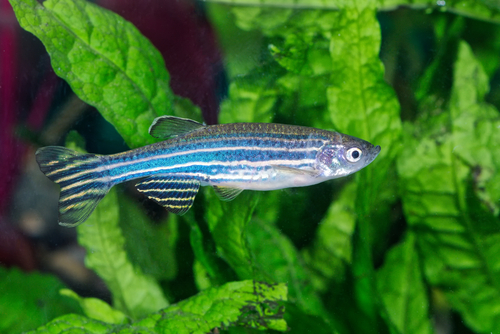
- Scientific Name: Danio rerio
- Grown Size: 1.5 inches
- Compatible with: Catfish, guppies, platys, mollies, swordtails
- Water Temperature: 64 – 75 °F
- Minimum tank size: 10 gal
- Care Level: Easy
These zebra-looking fish like water a little bit on the warmer side of things (closer to the 84°F upper limit we mentioned earlier) but they get along well with angelfish – especially when the zebras have been added to the tank in groups of five or six.
Smaller fish than you might think you could get away with with angelfish, the fact that these little creatures school up helps protect them from angelfish that would have otherwise been a little on the more aggressive side of things. The speed of these zebrafish help make sure that crafty angelfish won’t be able to catch them, too.
3. Swordtails
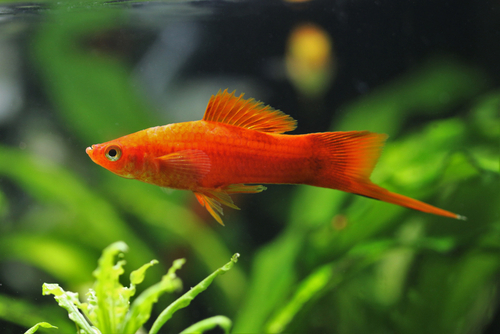
- Scientific Name: Xiphophorus hellerii
- Grown Size: 6.3 inches
- Compatible with: Cory catfish, platys, neon tetra, mollies, guppies
- Water Temperature: 72-79°F
- Minimum tank size: 15 gal
- Care Level: Medium
Far and away one of the best “community fish” you could add to your angelfish aquarium, the coolest thing about swordtails– aside from their friendly personality – is that they add a ton of color to your underwater world.
While they have a real playful demeanor (they can be the real class clowns of your underwater enclosure) they also don’t mind pushing back a little bit against fish that are more aggressive. Angelfish that start to “get big” with swordtails are going to find themselves rebuffed (peacefully) and dissuaded from that kind of attitude.
Best of all, these fish are about as simple to care for as it gets. They are live-bearing as well, so if you want to fill your enclosure with these fish you really don’t have to do much other than let breeding pairs go to work.
4. Guppy Fish
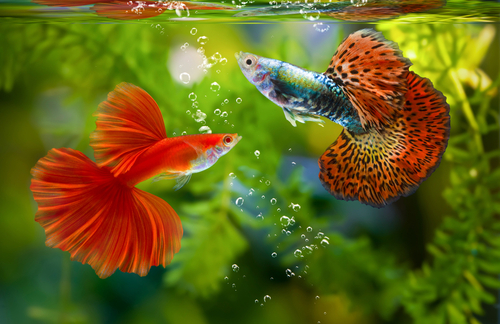
- Scientific Name: Poecilia reticulata
- Grown Size: 1.4 inches
- Compatible with: Cory catfish, mollies, platys, swordfish, loaches, tetras
- Water Temperature: 72 to 82 F
- Minimum tank size: 10 gal
- Care Level: Easy
Guppies are one of the most popular fish for brand-new aquarium owners and for good reason. These fish are hardy, fun, effortless to care for, and lead very active and colorful lives – making them a great addition to your angelfish enclosure.
One of the biggest reasons to consider adding these fish to your tank is because they are going to get along with all of the other kinds of tank mates you might want to pair up with an angelfish. You’ll be able to have a lot more tank diversity when you go this route, that’s for sure.
5. Keyhole Cichlids
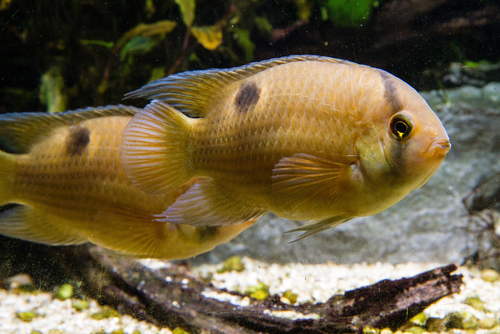
- Scientific Name: Cleithracara maronii
- Grown Size: 4.75 inches
- Compatible with: Cory catfish, tetras, suckerfish, catfish
- Water Temperature: 72 – 81°F
- Minimum tank size: 20 gal
- Care Level: Easy
Tracking down keyhole cichlid might not be the most simple or straightforward fish finding journey you undertake (lots of pet stores just don’t have them in stock), but making the extra effort is well worth it if you want a perfect angelfish tank make.
About as undemanding a fish as you are going to find on the market today, these fish have no real aggression whatsoever – though they do get plenty playful with angelfish as they bounce around inside your underwater enclosure.
It’s not a bad idea to have plenty of spots for these fish to hide, though. They like to dart in and out of their little secret passageways and get pretty distressed if they don’t have a lot of cover.
6. Platy Fish
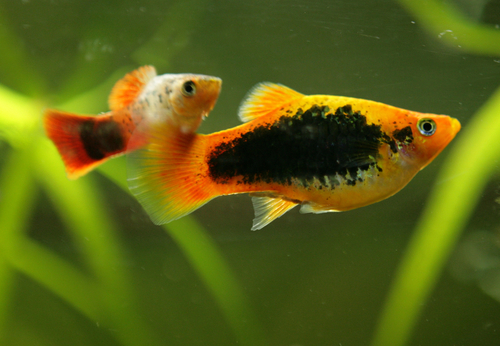
- Scientific Name: Xiphophorus maculatus
- Grown Size: 2.8 inches
- Compatible with: Tetras, cory catfish, bristlenose, rainbow fish
- Water Temperature: 70-82°F
- Minimum tank size: 10 gal
- Care Level: Easy
The difference between these fish caught in the wild and those raised in captivity is night and day. In the wild, these fish are dull and almost unremarkable. When raised in captivity, though, they have beautiful and vibrant colors that will add a lot of light and a lot of life into your angelfish enclosure.
On the smaller side of things, these social fish love to flit and flip around in little schools. They do best with angelfish when they have a couple of other tank mates to buddy up with, so keep that in mind.
7. Rosy Tetras
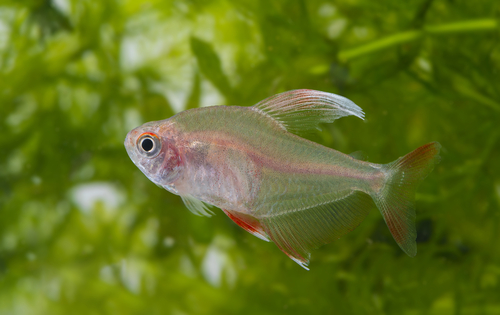
- Scientific Name: Hyphessobrycon rosaceus
- Grown Size: 2.5 inches
- Compatible with: Cory catfish, hatchetfish, dwarf cichlids, suckermouth catfish
- Water Temperature: 75-82 F
- Minimum tank size: 15 gal
- Care Level: Easy
Beautiful, super active, and yet incredibly peaceful tank mates for angelfish the only thing you’ll really have to worry about when adding these to your angelfish enclosure is whether or not your angelfish will consider them lunch sometime down the line.
The best way to prevent your angelfish population from munching on these rosy red tetras is to add at least six or seven of them at a time. Any less than that and they won’t be able to school up and defend themselves with sheer numbers.
8. Neon Tetras
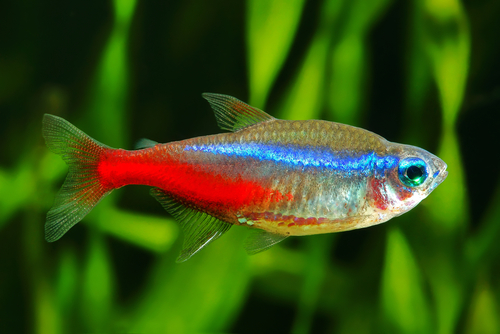
- Scientific Name: Paracheirodon innesi
- Grown Size: 1.5 inches
- Compatible with: Cory catfish, guppies, tetras, loaches
- Water Temperature: 75° – 80° F
- Minimum tank size: 10 gal
- Care Level: Medium
This recommendation is a little bit on the controversial side of things. Some people love the idea of keeping neon tetras with angelfish and some people say you have to be a little on the careful side of things.
We happen to think that there’s nothing wrong adding neon tetras to an angelfish enclosure so long as you are adding at least six or seven of them at a time.
Just like other tetras, when these fish are added in small groups (or alone) they can often become prey even for fish that are as generally peaceful as angelfish usually are.
9. Rummy Nose Tetras

- Scientific Name: Hemigrammus rhodostomus
- Grown Size: 1.5 inches
- Compatible with: Green Neon Tetra, Pearl Gourami, Corydoras Catfish, Hatchetfis, Cherry Barb
- Water Temperature: 64° – 82° F
- Minimum tank size: 20 gal
- Care Level: Easy
The trick with adding these kinds of tetras to your angelfish enclosure is making sure that they are only ever added into the mix after they are adults and full grown.
Add them young and they are going to be snacks not just for your angelfish, but for a whole bunch of other tank mates as well.
Once again, like every other tetra, you want to be sure that you add these adult fish in to your angelfish tank in schools of six or more.
10. Ram Cichlids

- Scientific Name: Mikrogeophagus ramirezi
- Grown Size: 4 inches
- Compatible with: Cory catfish, dwarf gourami, platys, guppies
- Water Temperature: 78° – 85°F
- Minimum tank size: 20 gal
- Care Level: Medium
Sometimes called butterfly cichlids, these super colorful fish have a bit of a “dandy” look about them that makes them fantastic to keep in your aquarium – but there also peaceful, gentle, and playful, which makes them ideal tank mates for your angelfish (as well as any other fish you want to keep in your tank).
Just understand that these fish can be a little finicky when it comes to taking care of them. They like certain foods (live for frozen food, they hate flake and granule food) and they need water conditions to be really dialed in.
11. Molly Fish

- Scientific Name: Poecilia sphenops
- Grown Size: 6 inches
- Compatible with: Guppy Fish, Endlers, Platy, Swordtail, Neon Tetras
- Water Temperature: 75°-80°F
- Minimum tank size: 10 gal
- Care Level: Easy
It might sound corny, but molly fish and angelfish are a legitimate match made in heaven. These fish are about as perfect a pair of companions as you can imagine.
Mollies are super adaptive to a wide variety of different water conditions, to the point where they can even thrive in saltwater environments. Keeping them in water conditions that angelfish really like is nearly effortless.
Playful and nonaggressive, they get along with a lot of other tank mates you might consider adding into your angelfish enclosure. They do like to “nip” when they play, though, so small fish bites can break out – though they dissipate almost immediately.
12. Bristlenose Pleco
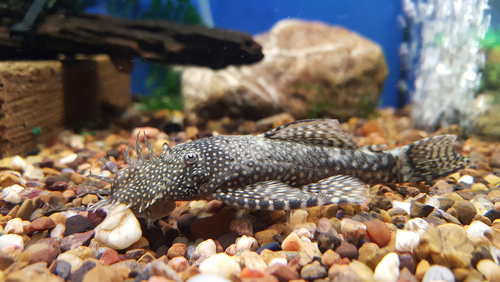
- Scientific Name: Ancistrus cirrhosus
- Grown Size: 4-5 inches
- Compatible with: Guppy Fish, Molly Fish, Platy Fish, Swordtail Fish, Corydoras, Gourami
- Water Temperature: 73-80 F
- Minimum tank size: 20 gal
- Care Level: Easy
Truth be told, you can drop these fish into almost any aquarium – including one filled with angelfish – and you’re not going to cause any real disruptions.
These bottom feeders stay out of the way for pretty much their entire lives, adding a little bit of flair and personality to your tank while at the same time making sure that it’s clean and generally free of toxins.
13. Rainbow Kribs
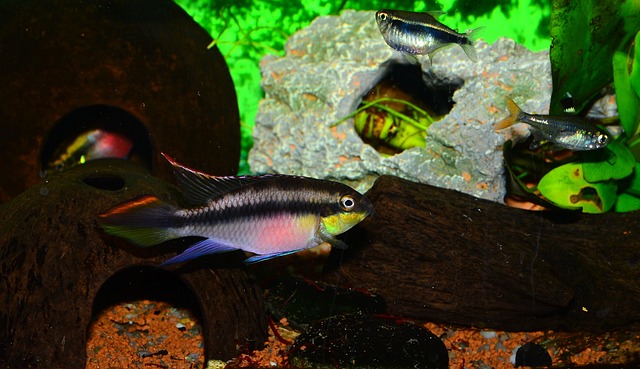
- Scientific Name: Pelvicachromis pulcher
- Grown Size: 3-4 inches
- Compatible with: Dwarf cichlids, tetras, and small barbs
- Water Temperature: 78 to 80 F
- Minimum tank size: 20 gal
- Care Level: Easy
Maybe not always the ideal companion for an angelfish, you can still somewhat reliably keep these fish together – though you need to be a little more vigilant.
The reason so many people like to add this fish to their angelfish enclosures is because rainbow kirbs are so easily adaptive to different conditions.
14. Lemon Tetras
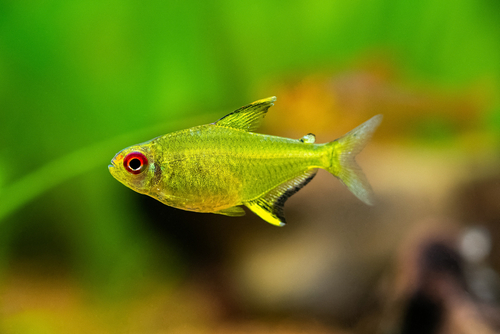
- Scientific Name: Hyphessobrycon pulchripinnis
- Grown Size: 2 inches
- Compatible with: Cory catfish, apistogramma, rasboras, danios
- Water Temperature: 72 – 82 F
- Minimum tank size: 20 gal
- Care Level: Easy
Angelfish and lemon tetras come from the same kind of environments deep in the Amazon River region, but if you’re going to keep them together you need to be sure that the tetras are in a (stop us if you’ve heard this already!) school of at least six.
Peaceful, fun, and friendly, you really can’t go wrong with tetras in a tank that has angelfish in it.
15. Corydora Catfish
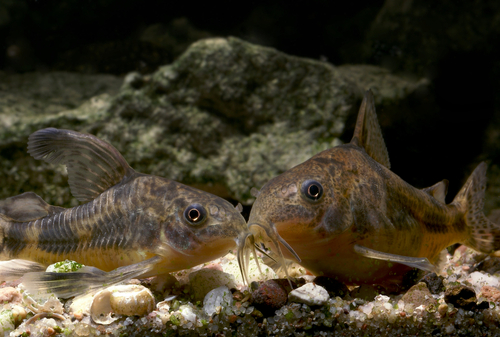
- Scientific Name: Corydoras paleatus
- Grown Size: 2.5 inches
- Compatible with: Almost everything
- Water Temperature: 72-82 F
- Minimum tank size: 20 gal
- Care Level: Easy
These catfish can be a little bit of a handful to keep happy at times, but if you make sure they can pair off (having even numbers of them at all times) you won’t have much to worry about.
Super low maintenance, very passive, and bottom dwellers that work to keep your tank clean, it’s not hard to fall in love with these fish after a while!
Closing Thoughts
At the end of the day, finding the right tank mates to sort of “spice up” your angelfish aquarium is a whole lot easier than you might have though – especially when you use the inside info above.
Just be sure that you’re adding fish that won’t compete with angels, won’t try and steal their food, and aren’t all that aggressive.
Keep those things in mind and you’ll be good to go!
Frequently Asked Questions
Are there any fish you shouldn’t keep with angelfish?
Stay as far away from fish like bettas, goldfish, and shrimp. Those three underwater creatures mixed in with angelfish will cause a world of headache and hassle.
Are angelfish friendly neighbors?
Don’t worry at all about adding friendly, relatively peaceful fish to your angelfish population. These fish are great neighbors and friends when they don’t feel threatened.
How big a tank do I need if I want multiple fish all kept together?
The bigger the enclosure you can swing the happier you will be, but you’ll want at least a 55 gallon tank (or larger) if you’re going to keep multiple fish happy and healthy.

Ian Sterling, founder of Fishlab.com, began his aquarium journey over 30 years ago, driven by a deep fascination for fish and their diverse personalities. His website, Fishlab.com, is dedicated to making fishkeeping accessible and enjoyable, offering beginner-friendly guidance, expert insights, and a community for aquarists to connect and share experiences.


